There’s a tree killer on the loose in Oregon, and nobody knows how to stop it.
An invasive green beetle called the emerald ash borer arrived in the Midwest from Asia, and it’s killed over 100 million ash trees across the country since it was discovered in 2002.
Now it’s killing ash trees in Oregon, which don’t have any defenses against this invader.
“They’re basically sitting ducks,” said Wyatt Williams, an invasive species specialist for the Oregon Department of Forestry. “There’s nothing that can stop emerald ash borer from coming through. We can only slow it down.”
So far, infestations have been found in Washington, Marion, Yamhill and Clackamas counties.
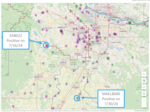
A map illustrating the location of two new detections of the emerald ash borer in Yamhill and Marion counties.
Courtesy of Oregon Department of Forestry
But experts say the beetle will eventually kill the vast majority of ash trees in Oregon, including native Oregon ash, which provides valuable shady streamside habitat for salmon and steelhead.
Officials are urging Oregonians not to move potentially infested firewood long distances, to check for ash trees around their homes and look for signs of beetle infestation. As the trees die, they can become hazardous and should be removed before they fall.
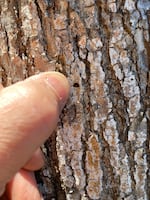
A D-shaped exit hole indicates an emerald ash borer infestation on an ash tree in Forest Grove, Ore.
Courtesy of Dominic Maze
Over the past few years, Oregon has mounted an aggressive response to the invasion, with state agencies using hundreds of traps to track the spread of the beetle, removing infested trees, destroying beetle larvae, injecting healthy ash trees nearby with pesticides that kill the beetles and protect the trees from infestation, and planting different tree species that can replace dying ash trees long-term.
However, the funding for many of those efforts is ending, and officials aren’t expecting more help from the federal government as beetle infestations spread across Oregon.
“It’s not going to stop,” Williams said. “We’re not able to slow the spread anymore. … Now is the time to get the word out. We are getting more infestations.”
The start of ‘a very depressing story’
“Cyrene and Zane, can you find the stumps from those trees?”
Last spring, City of Portland biologist Dominic Maze and his kids, 7-year-old Cyrene and 9-year-old Zane, took “Oregon Field Guide” to the site in Forest Grove where the three first discovered Oregon’s emerald ash borer beetle invasion.
“Dad, here’s a stump!” Cyrene called out, pointing down into a grassy area in the middle of the parking lot at Joseph Gale Elementary School.
In the summer of 2022, Dominic Maze was waiting in that parking lot to pick up his kids from summer camp. He was trying not to look at his phone, in keeping with a New Year’s resolution.
“So, I was just looking around,” he said. “I noticed within the parking lot there was a stand of very poor-looking ash trees — really haggard, all of them dying. … Then, just getting a real sinking feeling in the pit of my stomach.”
In his role with the city of Portland’s Bureau of Environmental Services, he’d been bracing for the arrival of the emerald ash borer for years. He asked his kids to look around for a little green beetle. And they found one.
“It landed on my hand,” Zane said, holding up his fingers to show the size of the beetle. “It’s like very tiny — about that big.”
“No, it’s not that big,” Cyrene told him, holding up her fingers to show a much bigger size.
Their dad settled the debate: “I think it’s probably about halfway between those two estimates,” he said. The metallic green beetle is about a half-inch long.
The heavily infested trees they discovered in 2022 were cut down, leaving only stumps in front of the school.
“And that was the start of what we knew was going to happen,” Dominic Maze said. “Emerald ash borer reaching Oregon — a very depressing story that’s about to play out in the Willamette Valley. It is like a death sentence.”
Losing irreplaceable habitat
The beetle hasn’t made it to ash trees in the city of Portland yet — as far as we know. But Dominic Maze is on the lookout.
He’s most worried about the habitat along rivers and creeks where native Oregon ash trees have a unique ability to provide shady streamside habitat.
“When we lose that Oregon ash, we lose that shade, we lose that habitat, and that shade is critical for keeping water cool,” he said. “And who likes cold water? All of our salmon species that pass through the city of Portland or rear their young here.”

Ash trees are vital to keeping streams and rivers shaded, and healthy for fish and other species. The map shows areas most likely to be impacted by the emerald ash borer.
Courtesy of Oregon Department Of Forestry
When the beetle kills the native Oregon ash trees, no other trees can fully replace them. Other trees, like cottonwood and willow, can’t thrive in the same conditions.
Invasive species such as Himalayan blackberry and English hawthorn are likely to spring up once they’re gone.
“Only Oregon ash can grow in the wettest, muckiest organic soil systems in the Willamette Valley,” he said. “This habitat is irreplaceable. The emerald ash borer represents a forest pest worst case scenario right now — loss of this irreplaceable keystone species — and we’re not gonna see any native trees replace it in most in many settings. …It’s gonna be bad.”
Slowing the spread
Last April, dozens of trees infested with emerald ash borer beetles were removed from Forest Grove – and the wood was chipped up or burned to destroy the beetle larvae.

In these provided photos, ash trees infested with the emerald ash borer beetle, left, were removed from Cornelius in April 2024. State agencies coordinated to remove dozens of trees from this neighborhood in Cornelius to slow the spread of the invasive beetle.
Images via the Oregon Department of Forestry
That was just one part of an elaborate strategy to slow the spread of this pest.
On the outskirts of that infestation, state workers created trap trees by girdling them. As those trees slowly die, they send out a distress signal that attracts any beetles nearby.
Later, the girdled trap trees were removed, and workers with the Oregon Department of Agriculture peeled back the bark to see how many beetle larvae they could find. The larvae eat through the wood under the tree bark, leaving squiggly lines and sawdust in their wake.
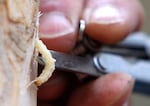
In this Oct. 26, 2011 file photo, an emerald ash borer larvae is removed from an ash tree in Saugerties, N.Y. The emerald ash borer, first found in 2002 in Michigan, is now in 30 states and has killed hundreds of millions of ash trees.
Mike Groll / AP
In November, Amber Basting, an insect survey tech with the Oregon Department of Agriculture, followed those lines to their source under the bark of one tree trunk.
“Oh, there’s a larva,” she said, removing a small white worm with tweezers and pointing to the extensive feeding gallery around it. “So this is how they’re killing the trees, as they’re eating through and cutting off the flow of nutrients and water up the tree, all that area around the gallery is starting to die.”
The larvae feed and spend the winter in pupal chambers inside the tree before turning into beetles and chewing their way out, leaving a D-shaped exit hole. Ash trees will usually die within five years of emerald ash borer beetle infestation.
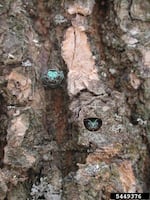
The emerald ash borer eats into the bark of ash trees and leaves D-shaped holes.
Debbie Miller / U.S. Forest Service
Matt Mills, an emerald ash borer support specialist with the Oregon Department of Forestry, said the state has employed multiple strategies for slowing the spread of the beetle.
“But so far, no one’s been able to stop it,” he said.
Last year, the state did thousands of visual surveys, looking for signs of emerald ash borer infestation. Officials created a detection ring around the known infestation in Forest Grove, creating hundreds of trap trees to identify which direction the beetles were moving.
At four locations around Forest Grove, the state released parasitoid wasps, which function as a biocontrol. The tiny wasps don’t have stingers, but they do have a unique ability to find the emerald ash borer larvae inside the tree bark using their antennae to sense the larval feeding activity. The wasps lay their eggs inside the emerald ash borer larvae, and the feeding wasp larvae kill the beetle larvae.
The state also treated hundreds of ash trees with pesticides to protect them from invasion by emerald ash borer beetles short term.
Signs of infestation
Last August, another emerald ash borer infestation was discovered near Woodburn in Marion County.
Max Ragozzino with the Oregon Department of Agriculture checked the trees for beetle damage, first noting the number of trees that had branches without leaves.
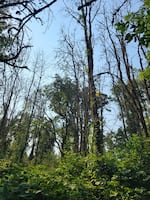
Ash trees infested with emerald ash borer beetles were discovered in Marion County in August 2024.
Courtesy of Wyatt Williams
“Unfortunately I think this is potentially the heaviest infestation of emerald ash borer in Oregon,” he said. “[Emerald ash borer] has probably been here for many years. If they’re not dead, most of these trees are not long for this world.”
Upon closer inspection, Ragozzino found splits in the bark of individual trees and multiple D-shaped exit holes.
“There’s a lot over here,” he said, pointing. “Boom, boom, boom. Right here, there’s the whole cluster of them. Each one of those indicates one beetle.”
Inside one of those holes, he found a beetle that didn’t make it out of the tree, but he said a lot of others did. He pulled off a chunk of bark that was full of the squiggly lines left behind by feeding beetles.
“A tree like this can produce easily 100 to 150 emerald ash borers in a year,” he said.
The tree also had another telltale sign of beetle infestation: fresh branches growing out of the trunk — the last gasp from a dying tree.
Preparing for the invasion
Biologist Laura Trunk has spent her whole career restoring the ash-dominated habitat at Jackson Bottom Wetlands in Hillsboro.
Now, the 635-acre wildlife preserve is home to thousands of ash trees facing near-certain death.
“It’s very sad what is coming,” Trunk said. “I have spent the last 16 years restoring Jackson Bottom. We’ve been removing invasive species for decades and we have built wetlands. We have put in a massive amount of effort into bringing this place back. And losing the trees is gonna be very difficult. Basically, we’re gonna have to start the restoration over.”
Trunk has an elaborate plan to prepare for the invasion, and she’s already started implementing it with pesticide treatments, ash tree removals and new tree plantings.
She plans to treat 360 ash trees every few years — including some giant Oregon ash trees that are hundreds of years old — to protect them from the beetle. But she can’t treat all of the ash trees on the property because it’s too labor-intensive. Statewide, Oregon will only be able to treat a relatively small number of ash trees.
The ash borer hasn’t made it to the preserve yet. And Trunk’s goal right now is to beat it to the punch. She’s opting to kill some of the ash trees on the property – with a crew of arborists – before the beetles can do it.

At Jackson Bottom Wetlands in Hillsboro, Laura Trunk has marked ash trees for removal with red dots as part of her plan to prepare for the invasive emerald ash borer beetle. The ash tree shown here in a video still captured in September 2024 will be felled and left on the ground for wildlife habitat.
Alan Zhou / OPB
“I work out here every day,” she said. “So I look and I’m like, ‘That tree’s gonna be dead. That tree is gonna be dead. OK, like a lot of these trees are gonna be dead.’ As these trees fall … these trees will fall on the trails. These trees will be hazardous for people.”
So, she’s making plans to remove, prune or treat every ash tree on the property – and she’s planting new species. She’s already removed hundreds of ash trees and replaced them with new trees.
Some of the bigger ash trees will be toppled and left on the ground to provide habitat for ground-dwelling wildlife. She’s removing only the tops of other trees, leaving them standing as snags for birds to nest in.
“Yeah, it’s ambitious,” she said. “This is not easy for us. … To lose these trees — it’s devastating.”
But all this work will create a stronger, more diverse forest, she said.
“Right now we just have ash, so when we lose it, we’ll have nothing,” Trunk said. ”Hopefully by the end of this we’ll have a more stable self-sustaining forested habitat with a lot more species so we don’t go through this again.”
A glimmer of hope
There is at least one small glimmer of hope for Oregon’s ash trees.
They didn’t evolve with emerald ash borer beetles from Asia — so they never developed any defenses against them.
But at the Dorena Genetic Resource Center, scientists Richard Sniezko and Glenn Howe are looking for any ash trees that have natural resistance to the beetle – so they can survive this pest.
They’re collecting seeds and planting test plots in Cottage Grove.
“I probably collected 10 or 15,000 seeds from individual trees,” Sniezko said. “And when the emerald ash borer moves into this area, this will be a test to see if there’s resistance.”
They’re hoping to find some survivors that have genetic defenses against the emerald ash borer, so the state might not have to say goodbye to Oregon ash forever.
“Most of our ash currently on the landscape are doomed,” Sniezko said. “But can we get ash back 20, 30, 40 years down the line? I want to know: Can I solve the problem and get the trees out there for future generations?”
What you can do
Gathering seeds from healthy ash trees is one thing people are doing in the face of this invasion — just in case any of those trees prove to have natural resistance to the emerald ash borer.
One way everyone can help is by checking ash trees for signs of beetle damage such as D-shaped holes in the bark or dead branches at the top of the tree that aren’t producing leaves.

In a video still from June 2024, Jordan Bartosz with the Oregon Department of Agriculture explains the distinctive leaf pattern of of an ash tree, which can help with identification.
Cameron Nielsen / OPB
“Right now is a good time to identify if you have an ash tree because they are leafing out right now,” Williams said. “It’s OK if you don’t even know what an ash tree is. We have a guide.”
This state map allows people to enter their address to learn what they should be doing now to prepare for the emerald ash borer. Infested trees can be reported to the state on this website.
Protective pesticide treatments can be injected into ash trees by certified arborists to kill invading beetles for two to three years.
Williams recommends people consider planting other tree species now and make a long-term plan to remove ash trees, so they don’t become dangerous when they get infested and start to die.
One easy way to slow the spread of the beetle is to avoid moving firewood more than 10 miles. Emerald ash borer beetles will only spread 1-4 miles every year on their own, but they can spread farther faster if people move them long distance.
“The number one way it will be spreading around Oregon is through infested wood,” Williams said.
As the summer camping season arrives, he said, one thing everyone can do is avoid moving infested wood. That’s likely how the beetle got here in the first place.



